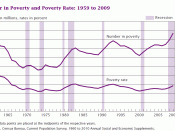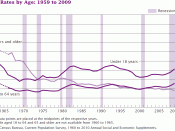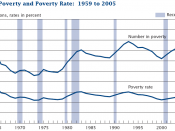U.S. Poverty
One in 11 families, one in nine Americans, and one in six children are officially poor. The wealthiest fifth of the population received half of all household income last year. The poorest fifth received 3.5%. The official poverty line is an income of $18,400 for a family of four. A single parent of two working full-time for a minimum wage would make $10,712. 40% of homeless men are veterans. Up to a fifth of America's food, worth 31 billion dollars, goes to waste each year, with 130lb of food per person ending up in landfills.
The United States recently experienced the longest period of economic expansion in its history. Despite this growth, poverty remains a persistent economic problem in America. In 2000, the official rate of poverty was 11.3 percent. Black and Hispanic people, female-headed households, and children experience particularly high rates of poverty relative to other groups.
Because of its persistence even in good times, poverty can seem like an inevitable problem. However, government programs with federal funding including Social Security, the Earned Income Tax Credit, Medicaid, and Food Stamps have achieved substantial reductions in poverty. Studies indicate that a relatively small increase in resources for these types of programs could help eliminate a large percentage of poverty in the United States. The number of Americans who live in poverty has risen for the second year in a row to 34.6 million, an increase of almost 3 million people since 2000. The proportion of Americans living in poverty increased to 12.1 percent in 2002. Children remained the age group most likely to be poor, with 16.7 percent of all children living in poverty, up from 16.3 percent in 2001. Poverty is defined, by the Census Bureau, as a situation in which the annual income...



Good essay
You do a good job of getting your thoughts across. I think your conclusion is too long tho. Your introduction and all of your body paragraphs are half the size. It might be better to end your paper with something that ties all of them together instead of starting a new idea.
2 out of 2 people found this comment useful.